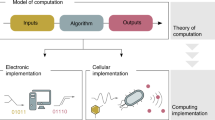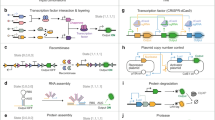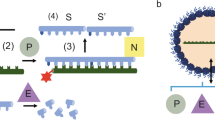Abstract
Ongoing efforts within synthetic and systems biology have been directed towards the building of artificial computational devices1 using engineered biological units as basic building blocks2,3. Such efforts, inspired in the standard design of electronic circuits4,5,6,7, are limited by the difficulties arising from wiring the basic computational units (logic gates) through the appropriate connections, each one to be implemented by a different molecule. Here, we show that there is a logically different form of implementing complex Boolean logic computations that reduces wiring constraints thanks to a redundant distribution of the desired output among engineered cells. A practical implementation is presented using a library of engineered yeast cells, which can be combined in multiple ways. Each construct defines a logic function and combining cells and their connections allow building more complex synthetic devices. As a proof of principle, we have implemented many logic functions by using just a few engineered cells. Of note, small modifications and combination of those cells allowed for implementing more complex circuits such as a multiplexer or a 1-bit adder with carry, showing the great potential for re-utilization of small parts of the circuit. Our results support the approach of using cellular consortia as an efficient way of engineering complex tasks not easily solvable using single-cell implementations.
This is a preview of subscription content, access via your institution
Access options
Subscribe to this journal
Receive 51 print issues and online access
$199.00 per year
only $3.90 per issue
Buy this article
- Purchase on Springer Link
- Instant access to full article PDF
Prices may be subject to local taxes which are calculated during checkout




Similar content being viewed by others
References
Bashor, C. J. & Horwitz, A. A. Peisajovich, S. G., & Lim, W. A. Rewiring cells: synthetic biology as a tool to interrogate the organizational principles of living. Ann. Rev. Biophys. 39, 515–537 (2010)
Amos, M. Cellular Computing (Oxford University Press, 2004)
Andrianantoandro, E., Basu, S., Karig, D. & Weiss, R. Synthetic biology: new engineering rules for an emerging discipline. Mol. Syst. Biol. 2, E1–E14 (2006)
Bray, D. Protein molecules as computational elements in living cells. Nature 376, 307–312 (1995)
Hjelmfelt, A., Weinbeger, E. D. & Ross, J. Chemical implementation of neural networks and Turing machines. Proc. Natl Acad. Sci. USA 88, 10983–10987 (1991)
McAdams, H. H. & Shapiro, L. Circuit simulation of genetic circuits. Science 269, 650–656 (1995)
Arkin, A. & Ross, J. Computational functions in biochemical reaction networks. Biophys. J. 67, 560–578 (1994)
Elowitz, M. B. & Leibler, S. A synthetic oscillatory network of transcriptional regulators. Nature 403, 335–338 (2000)
Gardner, T. S., Cantor, C. R. & Collins, J. J. Construction of a genetic toggle switch in Escherichia coli . Nature 403, 339–342 (2000)
Becskei, A. & Serrano, L. Engineering stability in gene networks by autoregulation. Nature 405, 590–593 (2000)
Voigt, C. A. Genetic parts to program bacteria. Curr. Opin. Biotechnol. 17, 548–557 (2006)
Kramer, B. P., Fischer, C. & Fussenegger, M. BioLogic gates enable logical transcription control in mammalian cells. Biotechnol. Bioeng. 87, 478–484 (2004)
Win, M. N. & Smolke, C. D. Higher-order cellular information processing with synthetic RNA devices. Science 322, 456–460 (2008)
Greber, D. & Fussenegger, M. An engineered mammalian band-pass network. Nucleic Acids Res. 38, e174 (2010)
Weber, W. et al. A synthetic mammalian gene circuit reveals antituberculosis compounds. Proc. Natl Acad. Sci. USA 105, 9994–9998 (2008)
Rinaudo, K. et al. A universal RNAi-based logic evaluator that operates in mammalian cells. Nature Biotechnol. 25, 795–801 (2007)
Purnick, P. E. M. & Weiss, R. The second wave of synthetic biology: from modules to systems. Nature Rev. Mol. Cell Biol. 10, 410–422 (2009)
Brenner, K., You, L. & Arnold, F. H. Engineering microbial consortia: a new frontier in synthetic biology. Trends Biotechnol. 26, 483–489 (2008)
Brenner, K., Karig, D. K., Weiss, R. & Arnold, F. H. Engineered bidirectional communication mediates a consensus in a microbial biofilm consortium. Proc. Natl Acad. Sci. USA 104, 17300–17304 (2007)
Danino, T., Mondragón-Palomino, O., Tsimring, L. & Hasty, J. A synchronized quorum of genetic clocks. Nature 463, 326–330 (2010)
You, L., Cox, R. S., III, Weiss, R. & Arnold, F. H. Programmed population control by cell-cell communication and regulated killing. Nature 428, 868–871 (2004)
Shou, W., Ram, S. & Vilar, J. M. G. Synthetic cooperation in engineered yeast populations. Proc. Natl Acad. Sci. USA 104, 1877–1882 (2007)
Weber, W., Daoud-El Baba, M. & Fussenegger, M. Synthetic ecosystems based on airbone inter- and intrakingdom communication. Proc. Natl Acad. Sci. USA 104, 10435–10440 (2007)
Balagaddé, F. K. et al. A synthetic Escherichia coli predator–prey ecosystem. Mol. Syst. Biol. 4, 187 (2008)
Lucks, J. B., Qi, L., Whitaker, W. R. & Arkin, A. P. Toward scalable parts families for predictable design of biological circuits. Curr. Opin. Microbiol. 11, 567–573 (2008)
Chin, J. W. Programming and engineering biological networks. Curr. Opin. Struct. Biol. 16, 551–556 (2006)
Rao, C. V., Wolf, D. M. & Arkin, A. P. Control, exploitation and tolerance of intracellular noise. Nature 420, 231–237 (2002)
Acknowledgements
We thank L. Subirana and S. Ovejas for technical support and S. Pellet and M. Peter for their help in setting up the microfluidics platform, and K. Kuchler for the FUS1-mCherry construct. S.R. is recipient of a FPU fellowship (Spanish Government). This work was supported by grants from the James McDonnell Foundation to R.S., the MICINN (BIO2009-07762 and FIS2009-12365); Consolider Ingenio 2010 programme (grant CSD2007-0015), from the ESF (ERAS-CT-2003-980409) FP6 as part of a EURYI scheme award (http://www.esf.org/euryi) to F.P. and the CELLCOMPUT (FP6) project to F.P., R.S. and S.H., and FP7 UNICELLSYS grant (#201142) to F.P. and S.H., and The Santa Fe Institute to R.S.; F.P. and R.S. laboratories are also supported by the Fundación Marcelino Botín (FMB). F.P. is recipient of an ICREA Acadèmia (Generalitat de Catalunya).
Author information
Authors and Affiliations
Contributions
All authors shared all the phases of the work. J.M. and R.S. developed the theoretical background for multicellular computing. Circuits were designed by S.R., J.M., N.C., E.N., F.P. and R.S.; S.R., N.C., K.F., J.K. and T.P. did the experimental designs. J.M., F.P., E.N., S.H. and R.S. wrote the paper.
Corresponding authors
Ethics declarations
Competing interests
The authors declare no competing financial interests.
Supplementary information
Supplementary Information
This file contains Supplementary Methods and Data, Supplementary Tables 1-2 and additional references. (PDF 282 kb)
Supplementary Figures
This file contains Supplementary Figures 1-11 with legends. (PDF 2028 kb)
Supplementary Data
This file contains Supplementary Dataset 2 (PDF 3170 kb)
Rights and permissions
About this article
Cite this article
Regot, S., Macia, J., Conde, N. et al. Distributed biological computation with multicellular engineered networks. Nature 469, 207–211 (2011). https://doi.org/10.1038/nature09679
Received:
Accepted:
Published:
Issue Date:
DOI: https://doi.org/10.1038/nature09679
This article is cited by
-
Addressable and adaptable intercellular communication via DNA messaging
Nature Communications (2023)
-
Customizing cellular signal processing by synthetic multi-level regulatory circuits
Nature Communications (2023)
-
Probing patterning in microbial consortia with a cellular automaton for spatial organisation
Scientific Reports (2022)
-
Distributed computation with continual population growth
Distributed Computing (2022)
-
Single strain control of microbial consortia
Nature Communications (2021)
Comments
By submitting a comment you agree to abide by our Terms and Community Guidelines. If you find something abusive or that does not comply with our terms or guidelines please flag it as inappropriate.



